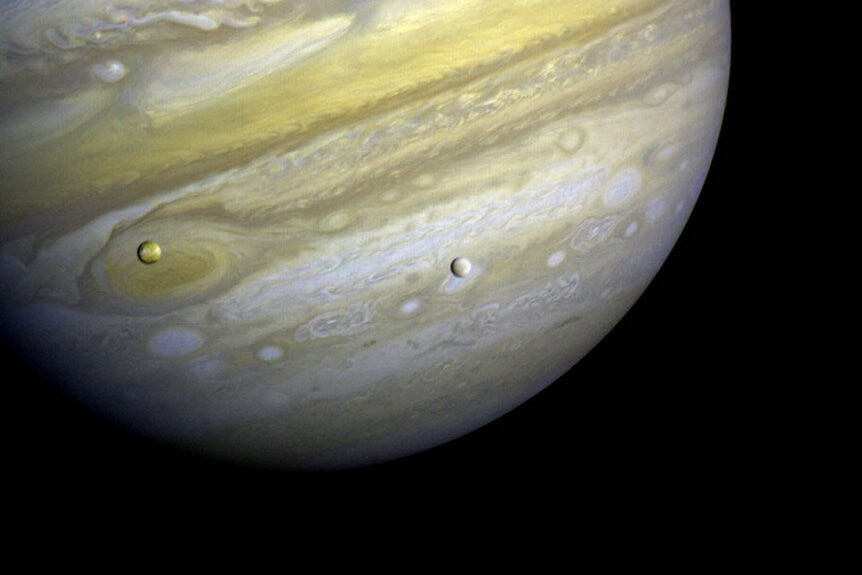Create a free profile to get unlimited access to exclusive videos, sweepstakes, and more!
Astronomers announce 12 previously undiscovered moons around Jupiter
We're verging on a hoarding situation.

On Feb. 1, we embarked on new deep space mission in Dean Devlin’s latest science fiction adventure, The Ark (streaming now on Peacock!). In the premiere episode, we joined the crew of the Ark One, on their way to a distant planetary colony around another star. The human crew and passengers are stored in stasis pods, sleeping soundly, when the ship suffers an impact in deep space. The ensuing damage wakes some of the passengers but it also knocks loose one of the bays, cutting the remaining passengers off from anyone who knew how to run the ship. It’s a less than ideal situation no matter where you are, but especially in the nearly empty space between stars. They’ve made it a good distance but they have a year left in their journey and only enough provisions for a few weeks. The question now is what they're going to do about it. To find out, we'll have to watch.
We tip our hats to the intrepid explorers willing to brave the trials of deep space in the name of exploration and the survival of our species, but we might be better off staying a little closer to home. Fortunately, thanks to a recent astronomical discovery, we now have even more to explore in our own solar system.
We’ve known for centuries that Jupiter was juggling a truly ridiculous number of moons, but it has never been clear precisely how many (and that’s probably still true). It seems like every time we look at Jupiter it pulls another moon out of its sleeve. It’s the planetary equivalent of a kid pulling rocks out of their pocket. There’s always one more. Despite being the biggest gravitational player in the solar system — aside from the Sun, of course — until recently Jupiter was playing second fiddle in the cosmic moon orchestra.
RELATED: Wait. Jupiter has *how* many moons?
For a while, Jupiter’s moon count sat at 80, while its next door neighbor Saturn has 83. The competition is tight but only between those two players. For comparison, Uranus and Neptune have 27 and 14 moons, respectively. Mars has two and Earth has only one (the best one). Now, however, thanks to a couple years of hard work by an international group of astronomers, it’s time to reset the scoreboard.
The International Astronomical Union’s Minor Planet Center recently updated Jupiter’s count to 92, adding 12 newly discovered moons. They hid from view so long because they are comparatively small and most of them are pretty far away from the planet. They range in size from 0.6 to 2 miles in diameter and were discovered using telescopes in Hawaii and Chile from 2021 to 2022.
After their discovery, astronomers needed to make additional observations of each individual object until they completed a full orbit. That’s to make sure they were actually moons and not something else just passing by. While some of the new moons orbit in the same direction as the rest of the Jovian system, 9 of the 12 have retrograde orbits, meaning they move in the opposite direction. That suggests they may have formed elsewhere in the solar system and were only captured by Jupiter later on.
RELATED: How many moons does Saturn have? A lot more now: Dozens of new ones have just been found
Scott Shephard, an astronomer from the Carnegie Institute, was part of the recent effort and knows his way around moon discovery. To date, he has contributed to the discovery of dozens of moons around Jupiter and Saturn, and he believes the number of moons around both planets will continue to go up, according to a statement. In fact, there are already additional potential moons which have been spied around Saturn, but astronomers have yet to track and define their orbits. Once that happens, it’s possible Saturn will once again claim the crown.
In the meantime, some of the new Jovian moons are waiting to receive official names, while others never will. That’s because moons have to be more than a mile wide to get a name. The runts will have to be satisfied with a collection of letters and numbers.
The more we gaze into the cosmos, and the closer we look, the more it's apparent there is so much to discover and learn, even relatively close to home.
Hopefully, we won’t have to leave for another system anytime soon, but to get a glimpse of what that might look like check out The Ark, streaming right now on Peacock!































